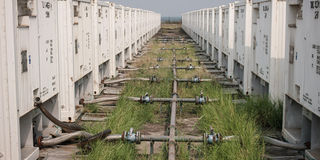Prime
Roadmap to Uganda’s first oil

Crude oil containers in Kasemene 1 in Bullisa District. PHOTO/file
What you need to know:
At peak levels, Uganda will produce up to 230,000 barrels of crude per day of which a maximum of 60,000 would be allocated to the refinery if in place.
Following the recent conclusion of key oil agreements related to the East African Crude Oil Pipeline (“EACOP”) project, Uganda is at the Final Investment Decision (FID) to develop the necessary infrastructure for crude oil production. The international oil companies (“IOCs”) now have the green light to start awarding major project contracts. Close to $15 billion is projected will be spent on building the crude oil processing and production facilities, EACOP and potentially the refinery. There is palpable excitement and revived optimism of economic prosperity from these forthcoming projects. To help manage public expectations, this article gives an overview of the road map to Uganda’s first oil.
The long journey to investment stage spanning over 16 years from the time oil was first discovered in 2006 is not surprising. As a nascent country finding oil for the first time, Uganda started from scratch putting together the necessary legislative and contractual framework to facilitate the fair allocation of the resource wealth to both the international oil companies, the government as well as the development of the requisite infrastructure. Negotiations to conclude the required agreements have been protracted and tense. In fact, the relationship between the IOCs and government dramatically soured in 2019 casting doubt on the future of the oil and gas sector in Uganda.
That these two parties have now struck compromise to move ahead the project is indeed monumental! A key lesson from these negotiations that government officials will take to future major project development negotiations is the necessity of compromise. Both government and the private sector are critical stakeholders.
Following years of deadlock, the IOCs and the government agreed in 2014 to develop both the refinery and pipeline as a means of commercialising Uganda’s oil discoveries. At peak levels, Uganda will produce up to 230,000 barrels of crude per day of which a maximum of 60,000 would be allocated to the refinery if it is in place. The refinery will process the crude into gasoline, petroleum and other related products while the pipeline would evacuate the crude oil to export markets through the port of Tanga in Tanzania. The EACOP is at investment stage while the refinery project is at front end engineering design stage to ascertain its actual development costs before calling its final investment decision.
The IOCs will now begin to award major project contracts to kick-start building of the crude oil production facilities and the EACOP. The successful bidders for the engineering, procurement and construction services, and drilling, logistics and supply contracts should be announced shortly. There will be simultaneous construction works for the requisite infrastructure to facilitate the production of the first barrel of crude oil projected to flow in about three years from the commencement of project works. In addition to the pipeline, the IOCs will commission the building of the central processing facilities (“CPFs”). The CPFs will be gather the crude oil and natural gas from the wellheads. CPFs help filter out the water, drilling additives and other unwanted substances that may be mixed with the crude oil. A network of pipelines will feed into the CPFs from the several wells projected to be drilled. Processed crude from the CPFs would then be pumped through the EACOP to the export markets or availed to the refinery.
The next six months are critical for any business intending to participate in Uganda’s oil and gas value chain. While some local entrepreneurs are concerned that they could be late for the party, this is likely not the case. As expected, major contracts will be awarded to international companies with robust technical and financial means to execute these mammoth projects. To comply with Uganda’s local content requirements as well as earn the goodwill or social license of the locals, the IOCs and the major contractors will however subcontract significant work streams to the locals. This is where the opportunities lie for Ugandans.
To facilitate Ugandans participate in the oil and gas business value chain, the law requires the IOCs and their contractors to unbundle major projects into manageable segments that the locals are able to undertake. The oil companies are further obliged to commit resources and effort to help Ugandan entrepreneurs improve their capacity to take part in the business of oil and gas. By the time first oil flows three years from the start of constructing the EACOP and other production facilities, $15 billion would have already been spent. So local entrepreneurs should position to tap into this.
Opportunities
Local content
To comply with Uganda’s local content requirements as well as earn the goodwill or social license of the locals, the international oil companies and the major contractors will however subcontract significant work streams to the locals. This is where the opportunities lie for Ugandans.
The author is the managing partner at Cristal Advocates.




